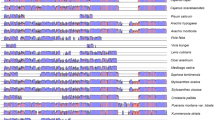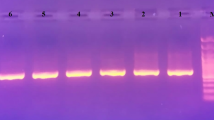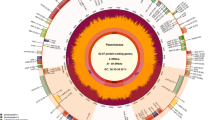Abstract
The chloroplast and mitochondrial DNA diversity of 61 genotypes belonging to 18 Vasconcellea species, the so-called highland papayas, was studied by PCR-RFLP analysis of two non-coding cpDNA regions (trnM-rbcL and trnK1-trnK2) and one non-coding mtDNA region (nad4/1-nad4/2). This sample set was supplemented with six genotypes belonging to three other Caricaceae genera: the monotypic genus Carica, including only the cultivated papaya, and the genera Jacaratia and Cylicomorpha. Moringa ovalifolia was added as an outgroup species. The PCR-amplified cpDNA regions were digested with 18 restriction endonucleases, the mtDNA region with 11. A total of 22 point mutations and four insertion/deletions were scored in the sample. A higher level of interspecific variation was detected in the two cpDNA regions in comparison to the analysis of the mtDNA. Wagner parsimony and Neighbor-Joining analysis resulted in dendrograms with similar topologies. PCR-RFLP analysis supported the monophyly of Caricaceae, but among the 26 mutations scored, an insufficient number of markers discriminated between the different Caricaceae genera included in this study. Hence the inference of the intergeneric relationships within Caricaceae was impossible. However, some conclusions can be noted at a lower taxonomic level. The Caricaceae species were divided into two lineages. One group included only Vasconcellea spp., whereas the second included the remaining Vasconcellea spp., together with the papaya genotypes and those from the other Caricaceae genera. This may indicate a higher level of inter-fertility for the Vasconcellea species from the latter clade in interspecific crossings with papaya. The putative progenitors of the natural sterile hybrid V. × heilbornii, i.e. V. stipulata and V. cundinamarcensis, were only distantly related to V. × heilbornii. This indicates that probably none of these species was involved as the maternal progenitor in the origin of V. × heilbornii. Surprisingly, V. × heilbornii had organellar genome patterns identical with V. weberbaueri, suggesting a possible involvement of this species in the origin of V. × heilbornii. On the basis of discrepancy between morphological traits and the cpDNA profiles of some pairs of Vasconcellea species, we believe that besides V. × heilbornii, some other species have originated through interspecific hybridization. A reticulate evolution for Vasconcellea has therefore been suggested. Finally, intraspecific cpDNA variation was detected in V. microcarpa, thus providing molecular evidence for the high diversity previously indicated by morphological observations.



Similar content being viewed by others
References
Aradhya MK, Manshardt RM, Zee F, Morden CW (1999) A phylogenetic analysis of the genus Carica L. (Caricaceae) based on restriction fragment length variation in a cpDNA intergenic spacer region. Genet Res Crop Evol 46:579–586
Badillo VM (1967) Acerca de la naturalezea hibrida de Carica pentagona, C. chrysopetala y C. fructifragrans, frutales del Ecuador y Colombia. Rev Fac Agron Univ Centr Venez 4:3–14
Badillo VM (1971) Monografia de la familia Caricaceae. Publicada por la Associacion de Profesores, Univ Centr Venez, Venezuela
Badillo VM (1983) Caricaceae. In: Harling G, Sparre B (eds) Flora of Ecuador. Balogh Scientific Books, Illinois, pp 27–47
Badillo VM (1993) Caricaceae. Segundo esquema. Rev Fac Agron Univ Centr Venez 43:1–111
Badillo VM (2000) Carica L. vs. Vasconcella St. Hil. (Caricaceae): con la rehabilitación de este último. Ernstia 10:74–79
Badillo VM (2001) Nota correctiva Vasconcellea St. Hil y no Vasconcella (Caricaceae). Ernstia 11:75–76
Bremer B (1991) Restriction data from chloroplast DNA for phylogenetic reconstruction: is there only one accurate way of scoring? Plant Syst Evol 175:39–54
Bukhari YM, Koivu K, Tigerstedt PMA (1999) Phylogenetic analysis of Acacia (Mimosaceae) as revealed from chloroplast RFLP data. Theor Appl Genet 98:291–298
Cipriani G, Testolin R, Gardner R (1998) Restriction-site variation of PCR-amplified chloroplast DNA regions and its implications for the evolution and taxonomy of Actinidia. Theor Appl Genet 96:389–396
Cueva E (1999) Recolección, clasificación y estudio etnobotánico de los recursos fitogenéticos arbóreos y arbustivos nativos, productores de frutos comestibles, de la provincia de Loja. Dissertation, Universidad Nacional de Loja, Ecuador
Demesure B, Sodzi N, Petit RJ (1995) A set of universal primers for amplification of polymorphic non-coding regions of mitochondrial and chloroplast DNA in plants. Mol Ecol 4:129–131
Dowling TE, Moritz C, Palmer JD, Rieseberg LH (1996). Nucleic acids III: analysis of fragments and restriction sites. In: Hillis et al. (eds) Molecular systematics. Sinauer, Sunderland, Mass., pp 249–320
Drew RA, O’Brien CM, Magdalita PM (1998) Development of interspecific Carica hybrids. Acta Hortic 461:285–292
Dumolin S, Demesure B, Petit RJ (1995) Inheritance of chloroplast and mitochondrial genomes in pedunculate oak investigated with an efficient PCR method. Theor Appl Genet 91:1253–1256
Dumolin-Lapègue S, Pemonge MH, Petit RJ (1997) An enlarged set of consensus primers for the study of organelle DNA in plants. Mol Ecol 6:393–397
Food and Agriculture Organization (2002) Statistical databases of the Food and Agriculture Organization of the United Nations. http://apps.fao.org
Grant V (2003) Incongruence between cladistic and taxonomic systems. Am J Bot 90:1263–1270
Harris SA, Ingram R (1991) Chloroplast DNA and biosystematics: the effects of intraspecific diversity and plastid transmission. Taxon 40:393–412
Heywood VH (1985) Flowering plants of the world. Croom Helm, London
Horovitz S, Jimenez H (1967) Cruzamientos interespecificos e intergenericos en Caricaceas y sus implicaciones fitotecnicas. Agron Trop 17:323–344
Jansen RK, Michaels HJ, Wallace RS, Kim K-J, Keeley SC, Watson LE, Palmer JD (1992) Chloroplast DNA variation in the Asteraceae: phylogenetic and evolutionary implications. In: Soltis PE, Soltis DE, Doyle JJ (eds) Molecular systematics of plants. Chapman and Hall, New York, pp 252–279
Jiménez Y, Romero J, Scheldeman X (1999) Colección, caracterización y descripción de Carica × heilbornii nm. pentagona B., Carica pubescens (A.D.C.) Solms-Laub y Carica stipulata B., en la provincia de Loja. Rev Difus Técn Cient Fac Cienc Agric Univ Nac Loja 29:43–54
Jobin-Décor MP, Graham GC, Henry RJ, Drew RA (1997) RAPD and isozyme analysis of genetic relationships between Carica papaya and wild relatives. Genet Res Crop Evol 44:471–477
Kim MS, Moore PH, Zee F, Fitch MMM, Steiger DL, Manshardt RM, Paull RE, Drew RA, Sekioka T, Ming R (2002) Genetic diversity of Carica papaya as revealed by AFLP markers. Genome 45:503–512
Lotfy S, Luro F, Carreel F, Froelicher Y, Rist D, Ollitrault P (2003) Application of cleaved amplified polymorphic sequence method for analysis of the cytoplasmic genome among Aurantioideae intergeneric somatic hybrids. J Am Soc Hortic Sci 128:225–230
Madrigal L, Ortiz AN, Cooke RD, Fernandez RH (1980) The dependence of crude papain yields on different collection (‘Tapping’) procedures for papaya latex. J Sci Food Agric 31:279–285
Magdalita PM, Drew RA, Adkins SW, Godwin ID (1997) Morphological, molecular and cytological analysis of Carica papaya×C. cauliflora interspecific hybrids. Theor Appl Genet 95:224–229
Manshardt RM, Wenslaff TF (1989) Interspecific hybridization of papaya with other species. J Am Soc Hortic Sci 114:689–694
Mekako HU, Nakasone HY (1975) Interspecific hybridization among six Carica species. J Am Soc Hortic Sci 100:237–242
Morshidi M (1998) Genetic control of isozymes in Carica papaya L. Theor Appl Genet 103:89–94
National Research Council (1989) Highland papayas. In: Ruskin FR (ed) Lost crops of the Incas: little-known plants of the Andes with promise for worldwide cultivation. National Academy Press, Washington D.C., pp 252–261
Nei M, Li WH (1979) Mathematical model for studying genetic variation in terms of restriction endonucleases. Proc Natl Acad Sci USA 76:5267–5273
Nwakanma DC, Pillay M, Okoli BE, Tenkouano A (2003) Sectional relationships in the genus Musa L. inferred from the PCR-RFLP of organelle DNA sequences. Theor Appl Genet, DOI 10.1007/s00122-003-1340-y
Ogihara Y, Terachi T, Sasakuma T (1991) Molecular analysis of the hot spot region related to length mutation in wheat chloroplast DNAs. I. Nucleotide divergence of genes and intergenic spacer regions located in the hot spot region. Genetics 129:321–332
Olmstead RG, Palmer JD (1994) Chloroplast DNA systematics: a review of methods and data analysis. Am J Bot 81:1205–1224
Olson ME (2002) Intergeneric relationships whitin the Caricaceae-Moringaceae clade (Brassicales) and potential morphological synapomorphies of the clade and its families. Int J Plant Sci 163:51–65
Palmer JD (1987) Chloroplast DNA evolution and biosystematic uses of chloroplast DNA variation. Am Nat 130:S6–S29
Palmer JD (1992) Comparison of chloroplast and mitochondrial genome evolution in plants. In: Herrmann R (ed) Cell organelles. Springer, Berlin Heidelberg New York, pp 99–133
Parani M, Lakshmi M, Ziegenhagen B, Fladung M, Senthilkumar P, Parida A (2000) Molecular phylogeny of mangroves VII. PCR-RFLP of trnS-psbC and rbcL gene regions in 24 mangrove and mangrove-associated species. Theor Appl Genet 100:454–460
Purseglove JW (1974) Tropical crops: dicotyledons. Longman, London, pp 86–104
Rodman JE, Soltis PS, Soltis DE, Sytsma KJ, Karol KG (1998) Parallel evolution of glucosinolate biosynthesis inferred from congruent nuclear and plastid gene phylogenies. Am J Bot 85:997–1006
Saitou N, Nei M (1987) The neighbour-joining method: a new method reconstructing phylogenetic trees. Mol Biol Evol 4:406–425
Sanderson MJ, Donoghue MJ (1989) Patterns of variation in levels of homoplasy. Evolution 43:1781–1795
Soltis DE, Soltis PS, Collier TG, Edgerton ML (1991) Chloroplast DNA variation within and among genera of the Heuchera group (Saxifragaceae): evidence for chloroplast transfer and paraphyly. Am J Bot 78:1091–1112
Sondur SN, Manshardt RM, Stiles JI (1996) A genetic linkage map of papaya based on randomly amplified polymorphic DNA markers. Theor Appl Genet 93:547–553
Stiles JI, Lemme C, Sondur S, Morshidi MB, Manshardt RM (1993) Using randomly amplified polymorphic DNA for evaluating genetic relationships among papaya cultivars. Theor Appl Genet 85:697–701
Storey WB (1976) Papaya, Carica papaya. In: Simmonds NW (ed) Evolution of crop plants. Longman, London, pp 21–24
Swofford DL (2002) PAUP*. Phylogenetic analysis using parsimony (*and other methods), Version 4.0. Sinauer, Boston
Taberlet P, Gielly L, Pautou G, Bouvet J (1991) Universal primers for amplification of three non-coding regions of chloroplast DNA. Plant Mol Biol 17:1105–1109
Tsumura Y, Yoshimura K, Tomaru N, Ohba K (1995) Molecular phylogeny of conifers using RFLP analysis of PCR-amplified specific chloroplast genes. Theor Appl Genet 91:1222–1236
Van den Eynden V, Cueva E, Cabrera O (1999) Plantas silvestres comestibles del sur del Ecuador. Ediciones Abya-Yala, Quito, Ecuador
Van Droogenbroeck B, Breyne P, Goetghebeur P, Romeijn-Peeters E, Kyndt T, Gheysen G (2002) AFLP analysis of genetic relationships among papaya and its wild relatives (Caricaceae) from Ecuador. Theor Appl Genet 105:289–297
Van Raamsdonk LWD, Ensink W, Van Heusden AW, Vrielink-Van Ginkel M, Kik C (2003). Biodiversity assessment based on cpDNA and crossability results in selected species of Allium subgenus Rhizirideum. Theor Appl Genet 107:1048–1058
Villarreal L, Dhuique-Mayer C, Dornier M, Ruales J, Reynes M (2003) Evaluation de l’intérêt du babaco (Carica pentagona Heilb.). Fruits 58:39–52
Wolfe KH, Li WH, Sharp PM (1987) Rates of nucleotide substitution vary greatly among plant mitochondrial, chloroplast and nuclear DNAs. Proc Natl Acad Sci USA 84:9054–9058
Acknowledgements
The authors thank Dr. Drew, Dr. Fichet, Dr. Thuan, Dr. Muasya, Dr. Zee and Dr. Ming for providing leaf material or DNA. This research project was funded by the Flemish Fund for Scientic Research (FWO-Vlaanderen Project no. 3G005100). Appreciation for assistance during sample collection and cooperation in Ecuador is extended to Naturaleza & Cultura Internacional. The experiments comply with current Belgian laws and regulations.
Author information
Authors and Affiliations
Corresponding author
Additional information
Communicated by H. Nybom
Rights and permissions
About this article
Cite this article
Van Droogenbroeck, B., Kyndt, T., Maertens, I. et al. Phylogenetic analysis of the highland papayas (Vasconcellea) and allied genera (Caricaceae) using PCR-RFLP. Theor Appl Genet 108, 1473–1486 (2004). https://doi.org/10.1007/s00122-003-1575-7
Received:
Accepted:
Published:
Issue Date:
DOI: https://doi.org/10.1007/s00122-003-1575-7




